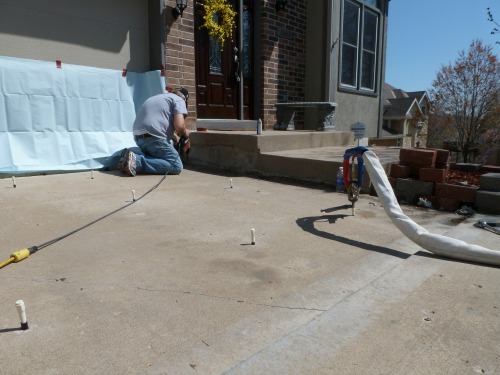Concrete lifting foam is used to level, raise, or lift concrete. This procedure works to correct uneven concrete by affecting the soil beneath it. Since the early 1900s, slab or mud jacking has been used to repair and lift concrete slabs. This was done by pumping “grout” through the concrete, which pushed it up from below. This grout was made from crushed limestone, water, and cement.
Cracks in your concrete or a difference in height between concrete slabs are a few of the indications that your concrete is sinking. Your home may be new or less than 10 years old, but the concrete around your home shows signs of sinking (the driveway or steps are falling away from the house.) You’d like to blame the contractor, but it is not their fault. Concrete that is sinking or cracking may be because the soil underneath the concrete slab (driveway, sidewalk, patio, or deck) has consolidated, the soil conditions are drier than they once were, or the drainage system around your house is adding to the problem of sinking concrete.
Foam Lifting is a Modern Approach
Expanding polyurethane foam is a more modern approach to concrete leveling, providing a wider range of benefits than traditional mud jacking/grout techniques.
The Foam Lifting Technique is a fine-tuned system that is unique to every job that is tackled. It is not a matter of drilling and filling a few holes with foam. An experienced foam lifting contractor has to have in-depth knowledge of the product and the nuances of the equipment. They must have experience with the product in all kinds fo weather conditions. This experience will also be a precursor for the successful lifting of concrete. Concrete Raising Systems tests every batch of foam they receive from the manufacturer. They test to ensure the foam’s quality, fluidity, and curing are consistent from batch to batch. And  clean and test their equipment.
clean and test their equipment.
They also test the foam for weather conditions. Foam leveling is a two-part polymer process that uses gun-type equipment to inject the foam through 5/8” holes. The equipment must always be checked to ensure the PSI and the rate at which the parts are combined to create the injection process (that expands the air bubbles) are working correctly and effectively.
Use an expert- You won’t regret it
The weather, humidity, and weight of the foam (available in 3-8 pound lots) and experience can also affect the success of the foam’s ability to expand, raise the concrete, and cure in differing conditions. Only someone with much experience working with polyurethane foam can work with it successfully in various situations.
Only an expert who consistently works with the Foam Lifting process to repair a sunken concrete slab will do it precisely and effectively every time. When these pre-check systems are put in place, it results in a job that does not have to be re-done (i.e., concrete sinks again in many traditional mudjacking jobs). Foam lifting with polyurethane is impervious to moisture, erosion, or settling. Cured foam retains its shape and volume, significantly reducing the chances of a new void forming.
When you do only do one thing- you do it exceptionally well
Concrete Raising Systems only does one thing: they raise concrete with foam. Concrete Raising Systems only uses polyurethane foam to lift, level, and raise a concrete driveway, sidewalk, patio, or porch. When you do only one thing in one way, you do it exceptionally well. When considering which approach to take for your cracking or sinking concrete, get all the information you can to make the best decision for your sunken concrete. Choose the best product and company with a proven track record for success. Choose Ken and Jason of Concrete Raising Systems of Kansas City.
This article has been recently updated.
The post Concrete Foam Lifting appeared first on Concrete Raising Systems- Concrete Lifting, Foam Jacking, Concrete Repair, Kansas City.

